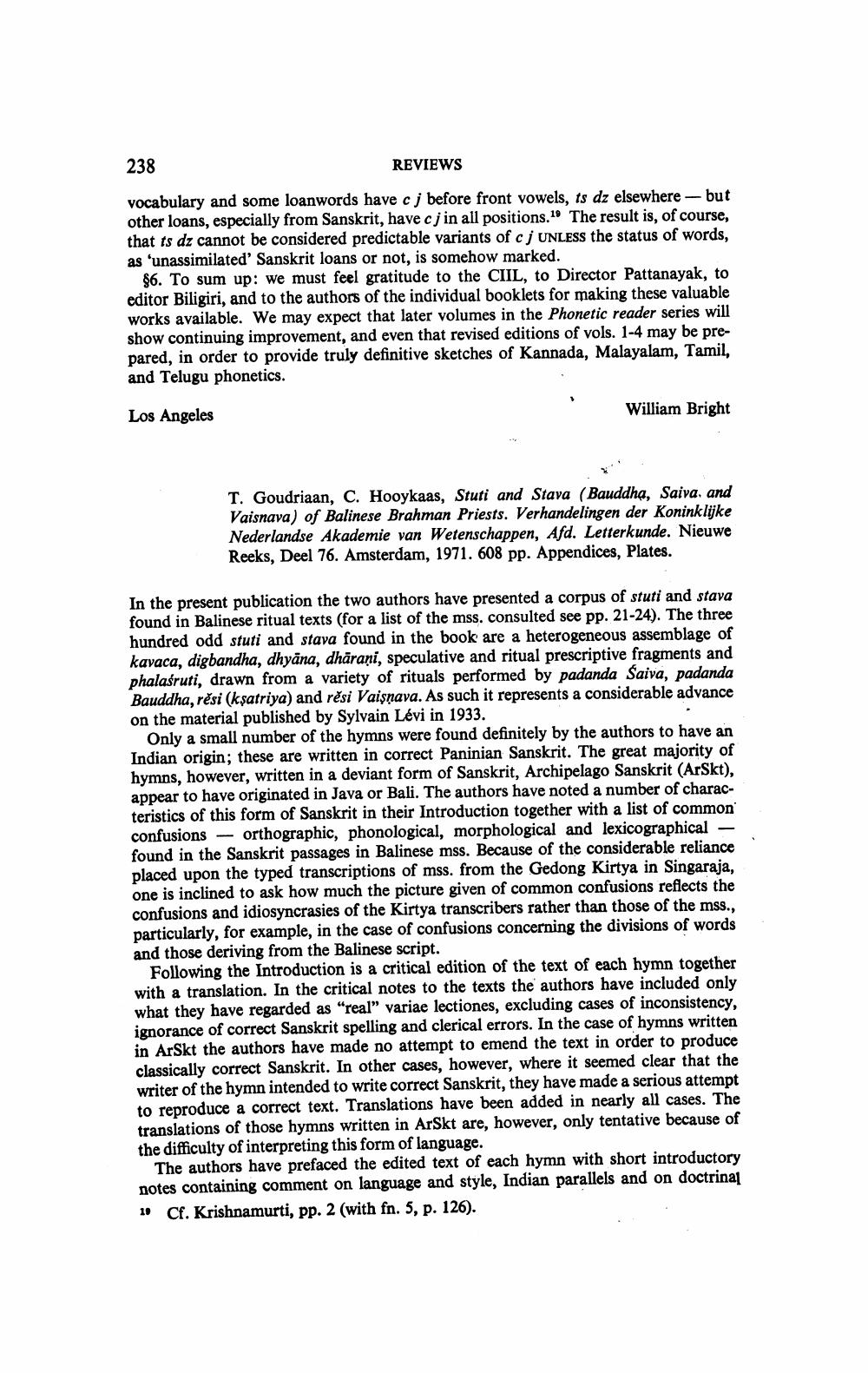________________ 238 REVIEWS vocabulary and some loanwords have cj before front vowels, ts dz elsewhere - but other loans, especially from Sanskrit, have cj in all positions.19 The result is, of course, that ts dz cannot be considered predictable variants of c | UNLESS the status of words, as 'unassimilated' Sanskrit loans or not, is somehow marked. 86. To sum up: we must feel gratitude to the CIIL, to Director Pattanayak, to editor Biligiri, and to the authors of the individual booklets for making these valuable works available. We may expect that later volumes in the Phonetic reader series will show continuing improvement, and even that revised editions of vols. 1-4 may be prepared, in order to provide truly definitive sketches of Kannada, Malayalam, Tamil, and Telugu phonetics. Los Angeles William Bright T. Goudriaan, C. Hooykaas, Stuti and Stava (Bauddha, Saiva, and Vaisnava) of Balinese Brahman Priests. Verhandelingen der Koninklijke Nederlandse Akademie van Wetenschappen, Afd. Letterkunde. Nieuwe Reeks, Deel 76. Amsterdam, 1971. 608 pp. Appendices, Plates. In the present publication the two authors have presented a corpus of stuti and stava found in Balinese ritual texts (for a list of the mss. consulted see pp. 21-24). The three hundred odd stuti and stava found in the book are a heterogeneous assemblage of kavaca, digbandha, dhyana, dharani, speculative and ritual prescriptive fragments and phalasruti, drawn from a variety of rituals performed by padanda Saiva, padanda Bauddha, resi (ksatriya) and resi Vaisnava. As such it represents a considerable advance on the material published by Sylvain Levi in 1933. Only a small number of the hymns were found definitely by the authors to have an Indian origin; these are written in correct Paninian Sanskrit. The great majority of hymns, however, written in a deviant form of Sanskrit, Archipelago Sanskrit (ArSkt), appear to have originated in Java or Bali. The authors have noted a number of characteristics of this form of Sanskrit in their Introduction together with a list of common confusions - orthographic, phonological, morphological and lexicographical - found in the Sanskrit passages in Balinese mss. Because of the considerable reliance placed upon the typed transcriptions of mss. from the Gedong Kirtya in Singaraja, one is inclined to ask how much the picture given of common confusions reflects the confusions and idiosyncrasies of the Kirtya transcribers rather than those of the mss., particularly, for example, in the case of confusions concerning the divisions of words and those deriving from the Balinese script. Following the Introduction is a critical edition of the text of each hymn together with a translation. In the critical notes to the texts the authors have included only what they have regarded as "real" variae lectiones, excluding cases of inconsistency, ignorance of correct Sanskrit spelling and clerical errors. In the case of hymns written in ArSkt the authors have made no attempt to emend the text in order to produce classically correct Sanskrit. In other cases, however, where it seemed clear that the writer of the hymn intended to write correct Sanskrit, they have made a serious attempt to reproduce a correct text. Translations have been added in nearly all cases. The translations of those hymns written in ArSkt are, however, only tentative because of the difficulty of interpreting this form of language. The authors have prefaced the edited text of each hymn with short introductory notes containing comment on language and style, Indian parallels and on doctrinal 19 Cf. Krishnamurti, pp. 2 (with fn. 5, p. 126).




